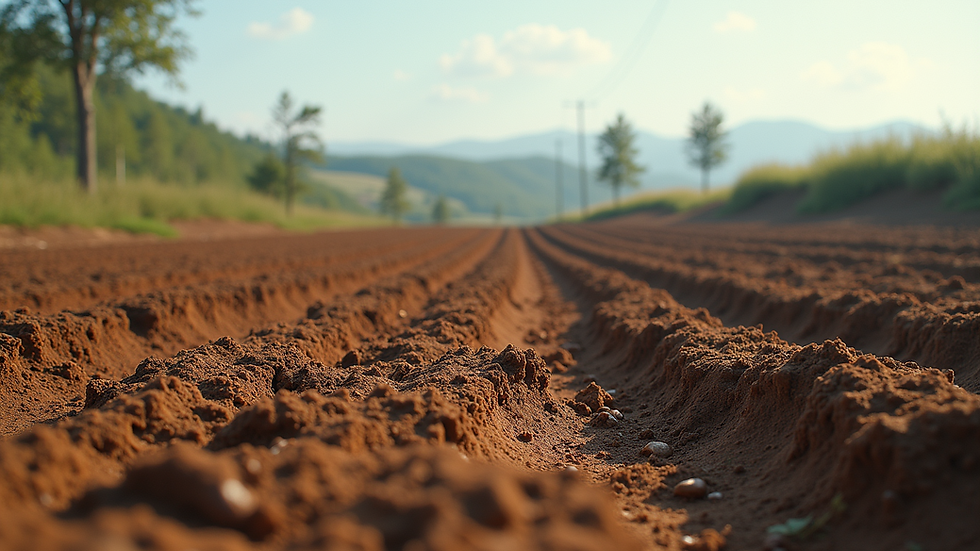Understanding the Importance of Soil Erosion Control
- Monarch Masonry Team

- May 24
- 4 min read
Soil erosion is a significant environmental concern that affects landscapes and agricultural productivity worldwide. It occurs when soil is worn away by natural forces such as water, wind, and human activities. Understanding the importance of soil erosion control is critical for maintaining the health of our ecosystems and supporting sustainable agriculture.
The Impact of Soil Erosion
Soil erosion has far-reaching impacts on agriculture, water quality, and biodiversity. According to the Food and Agriculture Organization (FAO), an estimated 24 billion tons of fertile soil vanish every year due to erosion. This loss directly affects crop yields and contributes to food insecurity.
Moreover, soil erosion can lead to sedimentation in rivers and lakes, impacting aquatic ecosystems. Excess sediment can suffocate fish habitats and disrupt the food chain. Addressing soil erosion is, therefore, essential not only for landowners but for the health of our water bodies and the biodiversity they support.

Understanding Soil Erosion Control Techniques
Controlling soil erosion involves implementing strategies that reduce the loss of topsoil. Various techniques can be employed depending on the specific type of erosion and the landscape. Some common methods include:
Vegetative Cover: Planting trees, shrubs, and grasses helps stabilize the soil. Their roots bind the soil, reducing the likelihood of erosion.
Contour Farming: This practice involves plowing across the slope of a field, rather than up and down. It creates natural barriers for water runoff, which helps retain soil and nutrients.
Terracing: More common in hilly regions, terracing involves creating flat areas (terraces) on slopes to slow down water runoff and reduce soil loss.
Mulching: Applying organic materials such as straw or wood chips on the soil surface can protect the soil from rain impact and help retain moisture.
Implementing these techniques can significantly minimize soil erosion and enhance land productivity. However, awareness and continuous education are critical for landowners and farmers.

What is the Cheapest Retaining Wall to Build?
Retaining walls serve a dual purpose: they prevent soil erosion and create usable flat space on sloped land. When it comes to budget-friendly options, several materials can be considered:
Timber Retaining Walls: Treated timber is often the least expensive option. Wooden walls can blend well with natural landscapes, but they may not last as long as other materials unless properly maintained.
Boulders or Stone: Natural stones can be a low-cost option if sourced locally. They provide aesthetic value and durability but may require more physical labor to construct.
Concrete Blocks: These are a reliable choice and can often be less expensive than natural stone. They are versatile and can be used to create straight or curved walls.
Among these, timber remains the cheapest option for those who prefer an easy-to-install solution. If a more durable solution is desired, considering alternative materials or professional options for retaining walls might be worthwhile.

The Role of Legislation in Erosion Control
Governments and local authorities have begun to recognize the importance of soil erosion control. Various legislation aims to protect soil health and promote sustainable farming practices. For example, regulations may require landowners to implement specific erosion control measures before development projects, especially in sensitive areas.
Additionally, financial incentives are often provided for farmers who adopt sustainable practices. These can include grants for planting cover crops or building earthworks such as ponds and grassed waterways. Engaging with local resource management offices can provide critical information for accessing these programs.
The Future of Soil Conservation
Looking ahead, advancements in technology and science continue to improve soil conservation methods. Precision agriculture, which employs data analysis and smart farming practices, allows farmers to monitor soil health more closely. This information can help make informed decisions about erosion control measures.
Furthermore, community initiatives are increasingly important in promoting soil erosion control. These grassroots efforts can mobilize residents to engage in tree planting, maintaining green belts, and creating educational programs about soil and land health.
By investing in education and community involvement, we can spread awareness about soil erosion, promoting better erosion control practices for future generations.
Taking Action for Soil Health
Soil erosion control is vital for environmental sustainability and agricultural productivity. Whether you are a farmer, landowner, or simply someone who cares about the planet, there are steps you can take to help:
Educate Yourself: Understand the signs of soil erosion and the benefits of soil health. Many resources are available online or through local extension services.
Implement Practices: Whether it’s planting grass along a streambank or adopting contour farming on your land, consider implementing erosion control practices.
Engage with Your Community: Join local conservation groups or initiatives that focus on protecting soil and water resources. Together, you can make a significant impact.
Advocate for Policy Changes: Support policies that promote sustainable land management and better erosion control practices at local and national levels.
By taking these actionable steps, we can all contribute to slowing down soil erosion and protecting the environment for future generations.

Ready to Get Started?
Let’s build something solid. Contact Monarch Masonry today for a free estimate or consultation.
📞 +1 (416) 649-6419



Comments